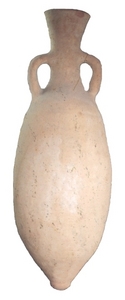Roman Amphorae: a digital resource
University of Southampton, 2005. (updated 2014) https://doi.org/10.5284/1028192. How to cite using this DOI
Data copyright © University of Southampton unless otherwise stated
This work is licensed under the ADS Terms of Use and Access.
Primary contact
Dr
David
Williams
Dept of Archaeology
University of Southampton
Avenue Campus
Highfield
Southampton
SO17 1BJ
England
Tel: 080 593032
Resource identifiers
- ADS Collection: 463
- DOI:https://doi.org/10.5284/1028192
- How to cite using this DOI
Porto Recanati

Courtesy of Dr. Tamás Bezeczky
Tamás Bezeczky
Distinctive FeaturesMercando (1974) was the first to mention the distinctive funnel-shaped rim of the Porto Recanati amphora ('anfora con collo ad imbuto'). The name of Porto Recanati was also applied to this type by Bruno (1989). Later it was mentioned by Carre (1985), and described by Toniolo (1993) and Mazzocchin (1993). The rim and the neck of the amphora is funnel-shaped, while the neck and the body form a continuous line. The body is egg-shaped, and the base is sometimes semicircular, while in other cases it is the same as those of the Dressel 6B amphorae. The handles are attached halfway between the rim and the body, are semicircular in form, and meet the upper part of the body. They are round and oval in cross-section. Some of the amphorae have a fine line on the rim, other have a horizontal groove. Rim stamps are rare.The body is very similar to Dressel 6B amphorae It has already been noted that the Dressel 6B forms change from the period of Domitian and Nerva. The rim is no longer curved but funnel-shaped. This may be the reason why it was supposed that these amphorae also had the Imperial stamp. No such amphora has been discovered in the Istrian workshops. It is possible that the Dressel 6B was used as a prototype when the 'Porto Recanati' type was created, and the two forms were produced parallel at the same time from the early Claudian period, one of them was produced in Istria, the other in northern Italy. The different formal characteristics and the petrological analyses make it clear that the `Porto Recanati` amphorae were not produced in the same workshop. Sauer distinguished two groups among the `Porto Recanati` amphorae in Vindobona, on the basis of the petrological analysis, the site of production should be located in northern Italy, similarly to the Schörgendorfer 558 amphorae. This is also suggested by the objects found there. It should be noted that one example in the ´Porto Recanati` fabric resembles the one fabric of Schörgendorfer amphorae. See characteristics | ||
Date RangeFrom the early Claudian period to the second century AD (Carre, 1985; Mazzocchin, 1993; Bezeczky, 1994).Search: [1st century AD] [2nd century AD] | ||
OriginNorthern Italy (Carre, 1985; Bezeczky-Sauer, 2005).Search: [Italy] [North West Europe] | ||
DistributionNorthern Italy, Noricum and Pannonia.Search: [Italy] [North West Europe] | ||
ContentsUnknown.Search: [Unknown] | ||
CommentsPrincipal contributor: Tamás Bezeczky | ||
ClassificationAnfora con collo ad imbutoAquileia 2 | ||



 3D models
3D models


